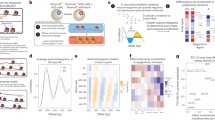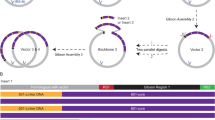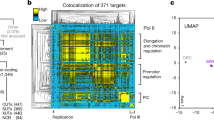Abstract
Here we use single-molecule imaging to determine coarse-grained intrinsic energy landscapes for nucleosome deposition on model DNA substrates. Our results reveal distributions that are correlated with recent in silico predictions, reinforcing the hypothesis that DNA contains some intrinsic positioning information. We also show that cis-regulatory sequences in human DNA coincide with peaks in the intrinsic landscape, whereas valleys correspond to nonregulatory regions, and we present evidence arguing that nucleosome deposition in vertebrates is influenced by factors that are not accounted for by current theory. Finally, we demonstrate that intrinsic landscapes of nucleosomes containing the centromere-specific variant CenH3 are correlated with patterns observed for canonical nucleosomes, arguing that CenH3 does not alter sequence preferences of centromeric nucleosomes. However, the nonhistone protein Scm3 alters the intrinsic landscape of CenH3-containing nucleosomes, enabling them to overcome the otherwise exclusionary effects of poly(dA-dT) tracts, which are enriched in centromeric DNA.
This is a preview of subscription content, access via your institution
Access options
Subscribe to this journal
Receive 12 print issues and online access
$189.00 per year
only $15.75 per issue
Buy this article
- Purchase on Springer Link
- Instant access to full article PDF
Prices may be subject to local taxes which are calculated during checkout




Similar content being viewed by others
References
Rando, O.J. & Ahmad, K. Rules and regulation in the primary structure of chromatin. Curr. Opin. Cell Biol. 19, 250–256 (2007).
Morris, C.A. & Moazed, D. Centromere assembly and propagation. Cell 128, 647–650 (2007).
Widom, J. Structure, dynamics, and function of chromatin in vitro. Annu. Rev. Biophys. Biomol. Struct. 27, 285–327 (1998).
Rando, O.J. & Chang, H.Y. Genome-wide views of chromatin structure. Annu. Rev. Biochem. 78, 245–271 (2009).
Luger, K., Mäder, A.W., Richmond, R.K., Sargent, D.F. & Richmond, T.J. Crystal structure of the nucleosome core particle at 2.8 Å resolution. Nature 389, 251–260 (1997).
Segal, E. et al. A genomic code for nucleosome positioning. Nature 442, 772–778 (2006).
Satchwell, S.C., Drew, H.R. & Travers, A.A. Sequence periodicities in chicken nucleosome core DNA. J. Mol. Biol. 191, 659–675 (1986).
Rice, P.A., Yang, S., Mizuuchi, K. & Nash, H.A. Crystal structure of an IHF-DNA complex: a protein-induced DNA U-turn. Cell 87, 1295–1306 (1996).
Struhl, K. Naturally occurring poly(dA-dT) sequences are upstream promoter elements for constitutive transcription in yeast. Proc. Natl. Acad. Sci. USA 82, 8419–8423 (1985).
Yuan, G.C. et al. Genome-scale identification of nucleosome positions in S. cerevisiae. Science 309, 626–630 (2005).
Lee, W. et al. A high-resolution atlas of nucleosome occupancy in yeast. Nat. Genet. 39, 1235–1244 (2007).
Whitehouse, I. & Tsukiyama, T. Antagonistic forces that position nucleosomes in vivo. Nat. Struct. Mol. Biol. 13, 633–640 (2006).
Segal, E. & Widom, J. Poly(dA:dT) tracts: major determinants of nucleosome organization. Curr. Opin. Struct. Biol. 19, 65–71 (2009).
Field, Y. et al. Distinct modes of regulation by chromatin encoded through nucleosome positioning signals. PLoS Comput. Biol. 4, e1000216 (2008).
Kaplan, N. et al. The DNA-encoded nucleosome organization of a eukaryotic genome. Nature 458, 362–366 (2009).
Black, B.E. et al. Structural determinants for generating centromeric chromatin. Nature 430, 578–582 (2004).
Meluh, P.B., Yang, P., Glowczewski, L., Koshland, D. & Smith, M.M. Cse4p is a component of the core centromere of Saccharomyces cerevisiae. Cell 94, 607–613 (1998).
Mizuguchi, G., Xiao, H., Wisniewski, J., Smith, M.M. & Wu, C. Nonhistone Scm3 and histones CenH3–H4 assemble the core of centromere-specific nucleosomes. Cell 129, 1153–1164 (2007).
Black, B.E. et al. Centromere identity maintained by nucleosomes assembled with histone H3 containing the CENP-A targeting domain. Mol. Cell 25, 309–322 (2007).
Black, B.E. & Bassett, E.A. The histone variant CENP-A and centromere specification. Curr. Opin. Cell Biol. 20, 91–100 (2008).
Camahort, R. et al. Scm3 is essential to recruit the histone H3 variant Cse4 to centromeres and to maintain a functional kinetochore. Mol. Cell 26, 853–865 (2007).
Stoler, S. et al. Scm3, an essential Saccharomyces cerevisiae centromere protein required for G2/M progression and Cse4 localization. Proc. Natl. Acad. Sci. USA 104, 10571–10576 (2007).
Pidoux, A.L. et al. Fission yeast Scm3: a CENP-A receptor required for integrity of subkinetochore chromatin. Mol. Cell 33, 299–311 (2009).
Williams, J.S., Hayashi, T., Yanagida, M. & Russell, P. Fission yeast Scm3 mediates stable assembly of Cnp1/CENP-A into centromeric chromatin. Mol. Cell 33, 287–298 (2009).
Baker, R.E. CENP-A targeting moves a step back. Mol. Cell 33, 411–413 (2009).
Aravind, L., Iyer, L.M. & Wu, C. Domain architectures of the Scm3p protein provide insights into centromere function and evolution. Cell Cycle 6, 2511–2515 (2007).
Sanchez-Pulido, L., Pidoux, A.L., Ponting, C.P. & Allshire, R.C. Common ancestry of the CENP-A chaperones Scm3 and HJURP. Cell 137, 1173–1174 (2009).
Dunleavy, E.M. et al. HJURP is a cell-cycle-dependent maintenance and deposition factor of CENP-A at centromeres. Cell 137, 485–497 (2009).
Foltz, D.R. et al. Centromere-specific assembly of CENP-a nucleosomes is mediated by HJURP. Cell 137, 472–484 (2009).
Dalal, Y., Furuyama, T., Vermaak, D. & Henikoff, S. Structure, dynamics, and evolution of centromeric nucleosomes. Proc. Natl. Acad. Sci. USA 104, 15974–15981 (2007).
Cumberledge, S. & Carbon, J. Mutational analysis of meiotic and mitotic centromere function in Saccharomyces cerevisiae. Genetics 117, 203–212 (1987).
Baker, R.E. & Rogers, K. Genetic and genomic analysis of the AT-rich centromere DNA element II of Saccharomyces cerevisiae. Genetics 171, 1463–1475 (2005).
Malik, H.S. & Henikoff, S. Conflict begets complexity: the evolution of centromeres. Curr. Opin. Genet. Dev. 12, 711–718 (2002).
Espelin, C.W., Simons, K.T., Harrison, S.C. & Sorger, P.K. Binding of the essential Saccharomyces cerevisiae kinetochore protein Ndc10p to CDEII. Mol. Biol. Cell 14, 4557–4568 (2003).
Fazio, T., Visnapuu, M.L., Wind, S. & Greene, E.C. DNA curtains and nanoscale curtain rods: high-throughput tools for single molecule imaging. Langmuir 24, 10524–10531 (2008).
Visnapuu, M.L., Fazio, T., Wind, S. & Greene, E.C. Parallel arrays of geometric nanowells for assembling curtains of DNA with controlled lateral dispersion. Langmuir 24, 11293–11299 (2008).
Sekinger, E.A., Moqtaderi, Z. & Struhl, K. Intrinsic histone-DNA interactions and low nucleosome density are important for preferential accessibility of promoter regions in yeast. Mol. Cell 18, 735–748 (2005).
Thåström, A., Bingham, L.M. & Widom, J. Nucleosomal locations of dominant DNA sequence motifs for histone-DNA interactions and nucleosome positioning. J. Mol. Biol. 338, 695–709 (2004).
Thåström, A., Lowary, P.T. & Widom, J. Measurement of histone-DNA interaction free energy in nucleosomes. Methods 33, 33–44 (2004).
Albert, I. et al. Translational and rotational settings of H2A.Z nucleosomes across the Saccharomyces cerevisiae genome. Nature 446, 572–576 (2007).
Creyghton, M.P. et al. H2AZ is enriched at Polycomb complex target genes in ES cells and is necessary for lineage commitment. Cell 135, 649–661 (2008).
Meneghini, M.D., Wu, M. & Madhani, H.D. Conserved histone variant H2A.Z protects euchromatin from the ectopic spread of silent heterochromatin. Cell 112, 725–736 (2003).
Raisner, R.M. et al. Histone variant H2A.Z marks the 5′ ends of both active and inactive genes in euchromatin. Cell 123, 233–248 (2005).
Zhang, H., Roberts, D.N. & Cairns, B.R. Genome-wide dynamics of Htz1, a histone H2A variant that poises repressed/basal promoters for activation through histone loss. Cell 123, 219–231 (2005).
Zilberman, D., Coleman-Derr, D., Ballinger, T. & Henikoff, S. Histone H2A.Z and DNA methylation are mutually antagonistic chromatin marks. Nature 456, 125–129 (2008).
Gribnau, J., Diderich, K., Pruzina, S., Calzolari, R. & Fraser, P. Intergenic transcription and developmental remodeling of chromatin subdomains in the human β-globin locus. Mol. Cell 5, 377–386 (2000).
Bank, A. Regulation of human fetal hemoglobin: new players, new complexities. Blood 107, 435–443 (2006).
Sankaran, V.G. et al. Human fetal hemoglobin expression is regulated by the developmental stage-specific repressor BCL11A. Science 322, 1839–1842 (2008).
Guenther, M.G., Levine, S.S., Boyer, L.A., Jaenisch, R. & Young, R.A. A chromatin landmark and transcription initiation at most promoters in human cells. Cell 130, 77–88 (2007).
Mavrich, T.N. et al. Nucleosome organization in the Drosophila genome. Nature 453, 358–362 (2008).
Mavrich, T.N. et al. A barrier nucleosome model for statistical positioning of nucleosomes throughout the yeast genome. Genome Res. 18, 1073–1083 (2008).
Ozsolak, F., Song, J.S., Liu, X.S. & Fisher, D.E. High-throughput mapping of the chromatin structure of human promoters. Nat. Biotechnol. 25, 244–248 (2007).
Schones, D.E. et al. Dynamic regulation of nucleosome positioning in the human genome. Cell 132, 887–898 (2008).
Wieland, G., Orthaus, S., Ohndorf, S., Diekmann, S. & Hemmerich, P. Functional complementation of human centromere protein A (CENP-A) by Cse4p from Saccharomyces cerevisiae. Mol. Cell. Biol. 24, 6620–6630 (2004).
Collins, K.A., Furuyama, S. & Biggins, S. Proteolysis contributes to the exclusive centromere localization of the yeast Cse4/CENP-A histone H3 variant. Curr. Biol. 14, 1968–1972 (2004).
Wittmeyer, J., Saha, A. & Cairns, B. DNA translocation and nucleosome remodeling assays by the RSC chromatin remodeling complex. Methods Enzymol. 377, 322–343 (2004).
Luger, K., Rechsteiner, T.J. & Richmond, T.J. Preparation of nucleosome core particle from recombinant histones. Methods Enzymol. 304, 3–19 (1999).
Prasad, T.K. et al. A DNA-translocating Snf2 molecular motor: Saccharomyces cerevisiae Rdh54 displays processive translocation and extrudes DNA loops. J. Mol. Biol. 369, 940–953 (2007).
Acknowledgements
We thank R. Axel, H. Bussemaker, R. Gonzalez, A. Grishok, R. Mann, and members of the Greene laboratory for critically reading the manuscript. We thank B. Cairns (University of Utah and the Howard Hughes Medical Institute (HHMI)) for S. cerevisiae H2A, H2B, H3 and H4 expression plasmids. We thank C. Wu and H. Xiao (National Institutes of Health) for the Cse4 and Scm3 expression plasmids and for sharing unpublished results. We thank J. Widom (Northwestern University) for the plasmid bearing the 601 nucleosome-binding sequence, and for communicating unpublished results. We thank L. Kaplan for cloning Flag-H4 and purifying Scm3, J. Gorman for assisting with data analysis and Y. Kwon (Yale University) for assistance with the salt dialysis protocol. This work was supported by a Basil O'Connor Starter Scholar Award from the March of Dimes and a grant from the US National Institutes of Health (GM082848) to E.C.G., and was partially funded by the Initiatives in Science and Engineering grant program through Columbia University, by the Nanoscale Science and Engineering Initiative of the National Science Foundation under NSF Award Number CHE-0641523 and by the New York State Office of Science, Technology, and Academic Research (NYSTAR).
Author information
Authors and Affiliations
Contributions
M.-L.V. performed all experiments; M.-L.V. and E.C.G. designed the experiments, analyzed and interpreted the data and wrote the manuscript.
Corresponding author
Supplementary information
Supplementary Text and Figures
Supplementary Figures 1–10 (PDF 2900 kb)
Supplementary Video 1
Nanofabricated DNA curtains. (MOV 1934 kb)
Supplementary Video 2
Visualizing DNA curtains and fluorescent nucleosomes. (MOV 2763 kb)
Rights and permissions
About this article
Cite this article
Visnapuu, ML., Greene, E. Single-molecule imaging of DNA curtains reveals intrinsic energy landscapes for nucleosome deposition. Nat Struct Mol Biol 16, 1056–1062 (2009). https://doi.org/10.1038/nsmb.1655
Received:
Accepted:
Published:
Issue Date:
DOI: https://doi.org/10.1038/nsmb.1655



